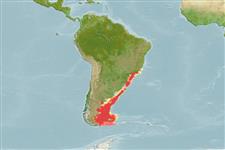| Native range | Point map | Year 2100 |

|
| Merluccius hubbsi AquaMaps Data sources: GBIF OBIS |
Length at first maturity
Lm 31.9 range ? - ? cm
Human uses
Fisheries: highly commercial
Phylogenetic diversity index
(Ref. 82805)
PD50 = 0.5000 many relatives (e.g. carps) 0.5 - 2.0 few relatives (e.g. lungfishes)
Trophic Level
(Ref. 69278)
4.2 ±0.67 se; Based on food items.
Resilience
(Ref. 69278)
Low, minimum population doubling time 4.5 - 14 years (K=0.13-0.19; tm=6)